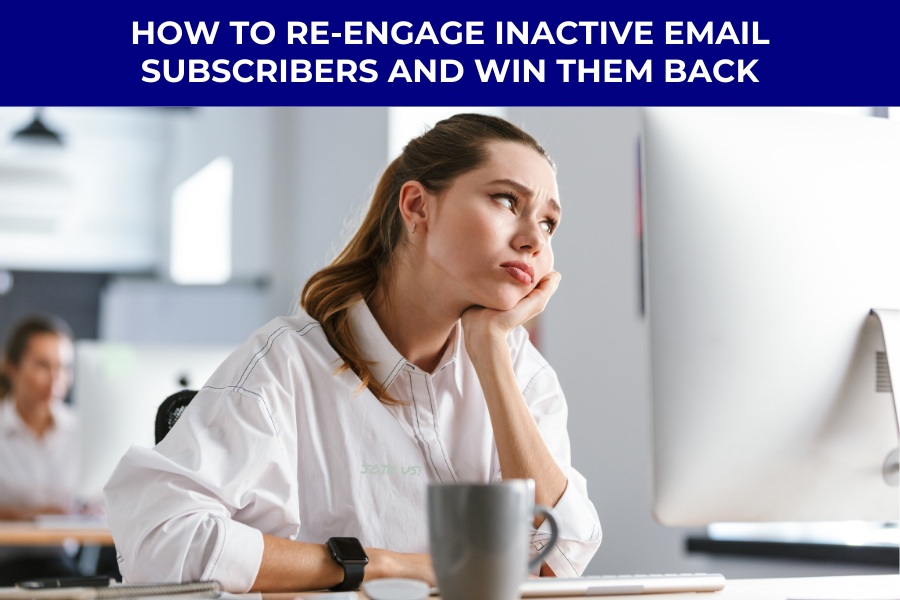Email marketing remains one of the most powerful tools for businesses, but even the best lists can suffer from subscriber inactivity over time. The good news? Winning back inactive subscribers is not only possible — it’s often more cost-effective than acquiring new ones. In fact, studies show that re-engaging existing contacts can be up to 25 times cheaper than attracting brand-new customers.
But beyond the numbers, there’s another compelling reason to focus on re-engagement: list health. A large number of inactive subscribers can hurt your email deliverability, making it harder for your messages to land in the inbox rather than the spam folder. That’s why identifying and reviving disengaged contacts is a critical part of maintaining a strong, responsive audience.
Why Do Email Subscribers Go Silent?
Before launching a re-engagement campaign, it helps to understand why subscribers might have gone quiet. Common reasons include:
Mismatched expectations : They signed up for a freebie but weren’t truly interested in your brand.
Irrelevant content : Sending the same message to everyone means some people will tune out.
Too many or too few emails : Bombarding subscribers leads to fatigue; disappearing for months makes them forget who you are.
Technical issues : Emails may be going to spam or bouncing due to outdated addresses.
Changed interests or dissatisfaction : People’s needs evolve, or they may have had a poor experience with your product or service.
Understanding these causes allows you to tailor your approach and make meaningful changes to your overall email strategy.
Why Bother Re-Engaging?
It’s tempting to just remove inactive email subscribers and move on, but here’s why you shouldn’t:
Cost-effectiveness : As mentioned, re-engagement is far cheaper than acquisition.
Hidden revenue potential : Even a small win-back rate can significantly boost your active subscriber base.
Improved deliverability : Fewer inactive users mean better engagement metrics and higher inbox placement rates.
More targeted marketing : Re-engagement efforts help you identify truly interested users, leading to better future campaigns.
Planning Your Re-Engagement Campaign
Start by defining what “inactive” means for your business. For daily newsletters, inactivity might be just 7–14 days without interaction. For others, 3–6 months might be acceptable. Once defined, use your email platform to identify and segment these email subscribers based on criteria like:
Time since last engagement
Past purchase history
Initial sign-up source (e.g., lead magnet download)
RFM (Recency, Frequency, Monetary) data
Segmentation allows you to send more personalized, relevant messages — a key factor in successful re-engagement.
Crafting the Right Message
Your campaign should ideally be a short email sequence — typically 3 to 5 emails — designed to grab attention and encourage action. Here are some effective strategies:
1. Personalization Beyond the Name
Use behavioral data to tailor subject lines and content. Mention their past interactions, recommend products they viewed, or suggest content similar to what they’ve engaged with before.
2. Offer Value
Give them a reason to return. This could be:
A discount or coupon
Exclusive content or early access
A contest entry or loyalty points
Make sure the offer feels exclusive and valuable — but still profitable for you.
3. Remind Them What They’re Missing
Reconnect them with your value proposition. Highlight recent updates, popular content, or community success stories.
4. Ask for Feedback
A quick survey or preference center update can provide insights and improve future targeting.
5. Create Urgency
Use limited-time offers or scarcity tactics (“Only 10 spots left!”) to prompt action.
6. Acknowledge Their Absence
Sometimes, a simple “We miss you” can spark a response. Be genuine and let them know you noticed they’ve been away.
Designing Effective Emails
Great content means little if your emails aren’t visually appealing and easy to read. Keep designs clean, mobile-friendly, and focused. Use strong, emotional, or curiosity-driven subject lines like:
“Still Interested?”
“We Miss You, [Name]”
“Last Chance to Stay Connected”
Structure your sequence with spacing in mind — wait 3–4 days between emails to avoid overwhelming recipients.
Tools & Automation
Most modern email platforms (like Mailchimp, Drip, or MailerLite) come equipped with automation workflows, segmentation tools, and analytics dashboards to help manage re-engagement campaigns efficiently.
Measuring Success
Track open rates, click-through rates, conversions, and redemption rates to see what’s working. A/B test different elements — subject lines, offers, timing — to refine your approach.
If someone doesn’t respond after multiple attempts, it’s okay to let go. Removing truly disengaged email subscribers improves list health and ensures your future campaigns reach people who care about your brand.
Final Thoughts
Re-engagement isn’t just about reducing churn — it’s about rebuilding relationships. It gives you the chance to reconnect, remind subscribers why they signed up, and offer them real value once again.
So instead of seeing inactive email subscribers as lost causes, view them as opportunities. With the right strategy, you can turn silence into conversation and bring your audience back into the fold.
Read more: How to Re-Engage Inactive Subscribers (And Why You Absolutely Should)










